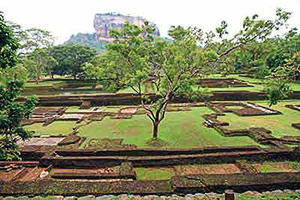Sigiriya Gardens, Ponds and Palaces
Miniature Gardens

Just inside the western gate of the Sigiriya Fortress are the Miniature Gardens. These gardens follow a mirror plan. That is the say each garden mirrors the other on the opposite side of the boulevard which run through the middle. Each garden is approximately ninety meters long and thirty meters wide. They are very different in layout and composition from the other gardens at Sigiriya. This suggests that this area was occupied and modified over the many centuries after Sigiriya was abandoned as a royal citadel.
There are five distinct areas in this garden which once had roofed pavilions, pools, courtyards, fountains, cisterns and winding waterways.
Discovered as recently as the late 1980s, only the southern section of these gardens has been excavated.
Pavilion Gardens
The Pavilion Gardens at Sigiriya where built during the reign of King Kashyapa I nearly 1600 years ago. They are the oldest surviving example of the charbagh quartered garden plan. It pre-dates similar designs at the Taj Mahal and Jaigarh Fort in India by over a thousand years. The gardens consist of a large walled compound with four massive L-shaped pools. At its center is an island linked to the main precinct by four causeways with ornate entrances. The pools were lined with brick, plastered, and then highly polished.
A covered passageway from each pool led to its own large walled compound which was used by the ladies of the king's harem for entertainment and relaxation.
Fountain Gardens
An interesting feature of the Fountain Gardens at Sigiriya is the sudden appearance and disappears of water. Waterfalls appear out of nowhere and streams seem to disappear into thin air. The lower level of the gardens has two long deep stepped pools which were once plastered and polished. Draining into these pools are a series of gentle waterfalls. The large waterfall is supplied by a shallow marble-lined pond. Water to this pond is supplied by a series of fountains interspersed along its length.
The terraces behind these water features were probably planted with brightly colored flowering plants. The main feature of the upper level is the meandering streams which flowed along its length and seem to appear and disappear unexpectedly.
The main feature of the upper level of these gardens is the meandering streams which flowed along its length and seem to appear and disappear unexpectedly. Water to these streams is supplied by storage tanks outside the Fountain Gardens.
Moated Palaces & Gardens
The Moated Palaces built over 1600 years ago at Sigiriya are mostly obscured from view and often overlooked by visitors. Located immediately behind the Fountain Gardens they are the largest gardens by area in the citadel.
SIGIRIYA - Novel

Palace intrigue, passion, deceit, betrayal and tragedy. Set fifteen hundred years ago, this compelling novel weaves historical facts into a remarkably entertaining story of fate, dangerous alliances, enduring friendships, and forbidden love. Available in Ebook and Paperback.
Where to Buy This BookThey consist of rectangular compounds surrounded by high retaining walls. Inside each are two large circular built-up islands surrounded by moats twenty meters wide. The moats were mainly for cooling and aesthetic purposes. On the flattened surfaces of each island are the Lower Palaces (Sitala Maliga). These may have been the royal residencies of King Kashyapa and his queen
Octagonal Pond & Gardens
The Octagonal Pond at Sigiriya is believed to have been used exclusively by the king and his immediate royal court. It is approximately 30 meters in diameter and 110 meters in circumference. It was originally brick-lined and plastered and contained brick staircases leading into it.
Before each use it was flushed out into the moat of the northwest Moated Palace and refilled with fresh water. A bathing pavilion was located on the far side of the pond. A drip-ledge from a lean-to roof is all that remains of this.
Next to this pond are an octagonal pavilion and a circular structure which appear to have been constructed after Kashyapa's time.
Boulder Gardens
The Sigiriya Boulder Gardens were built by King Kashyapa 1600 years ago and cover an area along the entire western side of the Sigiriya rock. It was intentionally organic and designed to create an illusion of natural harmony. Features are juxtaposed in irregular ways to strike the eye and create beautiful soothing compositions.
A number of boulders have rock shelters beneath them. Most of these shelters were originally constructed by Buddhist atheists from as early as the third century BC. Some contain inscriptions recording the names of patrons who donated them to the local monks. A noticeable feature of these shelters is the presence of drip-ledges, which prevent rainwater from flowing down into the caves. These shelters had been abandoned by the time Kashyapa moved to Sigiriya. Kashyapa's architects and landscapers cleverly incorporated these caves into their grand design, enhancing and decorating them to provide a surreal environment consistent with a paradise garden. On top of almost every boulder was built a pavilion of some sort of wood and masonry with tiled roofs. The hollow indentations, visible on these boulders today, are the tell-tale remains of footings incised into the rock for the foundations for these structures.
Some of the key features are the Cobra Hood Cave with an interesting motif on its ceiling, the King's Audience Hall with its huge stone throne hewn entirely from the rock and the Cistern Rock with a large water tank carved deep into the rock.
Terraced Gardens
The Terraced Gardens at Sigiriya are fashioned out of the natural hill at the base of the western slope of the Sigiriya rock. Roughly hewn granite blocks were used to build retaining walls with landings that rise in a series of concentric circles one above the other.
There are two massive brick stairways with limestone paving, which provide access from the Boulder Gardens through these gardens to the rock itself. The paths leading to these stairs are possibly the only two which bear some resemblance to the original paths. One of these stairways passes a cave believed to have been a shrine for the goddess Abhrasthita (Aphrodite). The other, via a large archway created by two boulders, also provides access to the terraced gardens above. Both these stairways terminate in a landing located near the middle of the western face of the rock. Beam holes cut into the rock suggest that this landing may once have been covered. The Mirror Wall commences from this landing.
